#lynn margulis
Text
On This Day In History
March 5th, 1938: American biologist Lynn Margulis was born. Her widespread contributions rewrote our understanding of early life and her ideas were so radical they were rejected and ignore for a decade before she was vindicated.
It’s thanks to Dr. Margulis that we understand why the mitochondria is the powerhouse of the cell!
240 notes
·
View notes
Text
On conflict theory
Basically, the first serious attempt at creating a scientific field of archaeology was done by 19th century Germans, and they looked around and dug some stuff up and concluded that the prehistoric world looked like the world of Conan the Barbarian: lots of “population replacement,” which is a euphemism for genocide and/or systematic slavery and mass rape. This 19th century German theory then became popular with some 20th century Germans who... uh... made the whole thing fall out of fashion by trying to put it into practice.
After those 20th century Germans were squashed, any ideas they were even tangentially associated with them became very unfashionable, and so there was a scientific revolution in archaeology! I'm sure this was just crazy timing, and actually everybody rationally sat down and reexamined the evidence and came to the conclusion that the disgraced theory was wrong (lol, lmao). Whatever the case, the new view was that the prehistoric world was incredibly peaceful, and everybody was peacefully trading with one another, and this thing where sometimes in a geological stratum one kind of house totally disappears and is replaced by a different kind of house is just that everybody decided at once that the other kind of house was cooler. The high-water mark of this revisionist paradigm even had people saying that the Vikings were mostly peaceful traders who sailed around respecting the non-aggression principle.
And then people started sequencing ancient DNA and...it turns out the bad old 19th century Germans were correct about pretty much everything. The genetic record is one of whole peoples frequently disappearing or, even more commonly, all of the men disappearing and other men carrying off the dead men's female relatives. There are some exceptions to this, but by and large the old theory wins.
from Mr & Mrs Smith, cf Margulis vs Dawkins, Graeber vs Hobbes, and critiques of Randall Collins's (via Weber) conflict theory
#lynn margulis#richard dawkins#john p smith#jane p smith#david graeber#thomas hobbes#randall collins#max weber
60 notes
·
View notes
Text
Omg i stumbled with an old nerdy comic that I made years ago
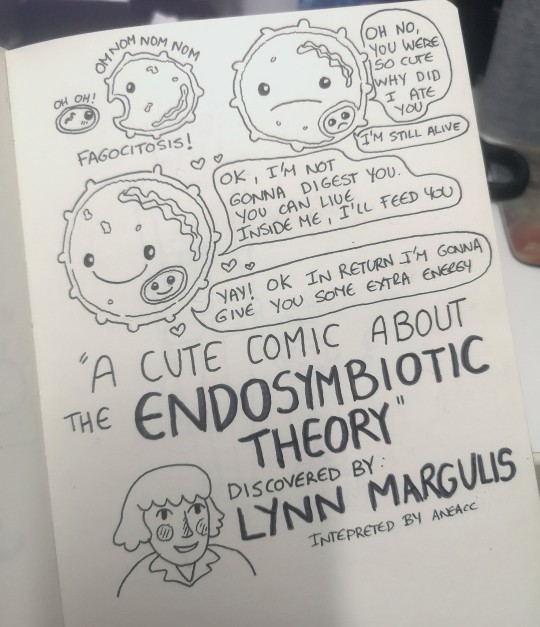
That I definitely should remake
6 notes
·
View notes
Text
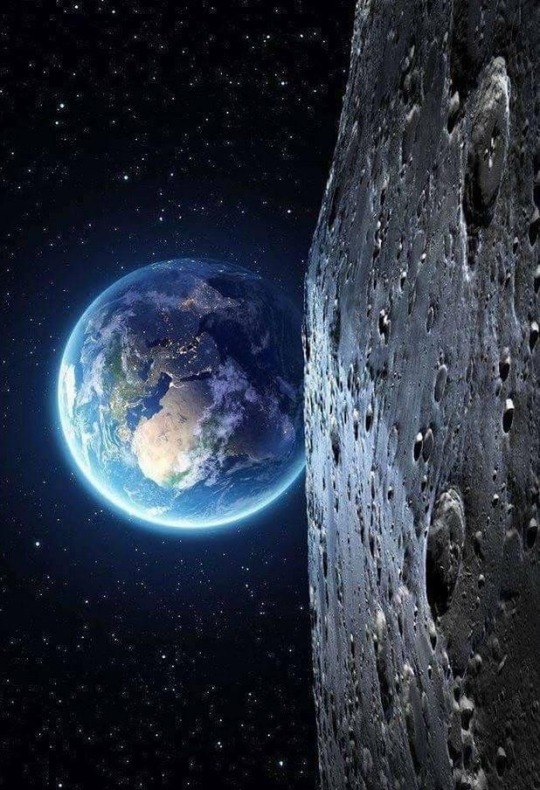
(Sherry Baker)
* * * *
Evolution is no linear family tree, but change in the single multidimensional being that has grown to cover the entire surface of Earth.
Lynn Margulis, American biologist and University Professor in the Department of Geosciences at the University of Massachusetts Amherst (1938-2011),What Is Life?, University of California Press, 2000. (via amiquote)
19 notes
·
View notes
Text
1 note
·
View note
Text
Lynn Margulis, la bióloga que situó la simbiosis en el centro de la evolución
▫️La bióloga evolutiva Lynn Margulis fue una de las principales contribuidoras a esta disciplina, gracias a su teoría de la endosimbiosis. Nació 5 de marzo de 1938, en Chicago (EE UU).
Por Curro Oñate
En su larga trayectoria recibió las máximas distinciones de la carrera científica en su campo, gracias al tamaño y calidad de su contribución investigadora. Los galardones incluyen la Medalla…

View On WordPress
1 note
·
View note
Text
In memoria di Gaia
In memoria di Gaia
Un piccolo viaggio mi ha impedito di scrivere qualcosa della morte a 103 anni di James Lovelock, lo scienziato britannico che insieme a Carl Sagan e Lynn Margulis ha impostato la teoria di Gaia , ovvero l’idea di un pianeta come sistema organico auto-organizzato. Un’idea così affascinante, anzi troppo affascinante che è stata ben presto trasformata in una favola per bambini senza alcun rigore…

Visualizza su WordPress
0 notes
Text
“[A]ny process that recombines genes (DNA) in an individual cell or organism from more than a single source. . . . [It] may occur at the nucleic acid, nuclear, cytoplasmic, and other levels.” Sex may occur through cosmic irradiation, virus and symbiont acquisition, or exposure to ambient chemicals.
—Myra Hird, Digesting Difference: Metabolism and the Question of Sexual Difference in Configurations 20:3
#quoting Lynn Margulis and Dorion Sagan; Origins of Sex: Three Billion Years of Genetic Recombination#finally some good sex#what i read#text#queue
0 notes
Text
man: “hey girl. you’re a biologist right?”
woman: “yes……. but I don’t understand physics. you must be so smart.”
man: “yes, physics is very complicated. but I can explain it to you.”
woman: “wow. forget being scientist in my own right, can I be your housewife?”
#Oppenheimer was stunning obviously#and I shouldn’t be surprised by this trope either in media or real life by now#but it still makes me groan#did u know that lynn margulis and carl sagan used to be married.#not for long#oppenheimer#barbenheimer
0 notes
Text
Hell no we are not letting this OFMD finale distract from that THIS LETTER.

Had a signature from Taika Waititi. I understand the sensitivity here this issue with Taika being Jewish(and that’s not my place as someone that’s Not Jewish or in those regions to condemn him on that perspective’s behalf) but this letter is directly bastardizing the situation.
Now, when there is a major production from a major figure in this platform that did this, is when we can make the most impact. Remember our values, even when those values involve a show that is strengthening the LGBTQ community.
Because this letter tore down the strength of the movement in support of Gaza. There are going to be so many people that saw this letter and take it completely uncritically, unchallenged.
Standing up for our values means sacrificing our interests, holding accountable the things we enjoy.
And also. I don’t want to see ANYONE. Being fucking antisemitic or racist towards Taika here. That is never appropriate and absolutely inexcusable behavior. You should he ashamed if you think that’s okay even after Taika’s actions.

[Text of Letter]
October 23, 2023
Dear President Biden, We are heartened by Friday's release of the two American hostages, Judith Ranaan and her daughter Natalie Ranaan and by today's release of two Israelis, Nurit Cooper and
Yocheved Lifshitz, whose husbands remain in captivity. But our relief is tempered by our overwhelming concern that 220 innocent people,
including 30 children, remain captive by terrorists, threatened with torture and death.
They were taken by Hamas in the savage massacre of October 7, where over 1,400
Israelis were slaughtered - women raped, families burned alive, and infants beheaded. Thank you for your unshakable moral conviction, leadership, and support for the Jewish people, who have been terrorized by Hamas since the group's founding over 35 years ago, and for the Palestinians, who have also been terrorized, oppressed, and victimized
by Hamas for the last 17 years that the group has been governing Gaza. We all want the same thing: Freedom for Israelis and Palestinians to live side by side in peace. Freedom from the brutal violence spread by Hamas. And most urgently, in this
moment, freedom for the hostages. We urge everyone to not rest until all hostages are released. No hostage can be left behind. Whether American, Argentinian, Australian, Azerbaijani, Brazilian, British, Canadian, Chilean, Chinese, Danish, Dutch, Eritrean, Filipino, French, German, Indian, Israeli, Italian, Kazakh, Mexican, Panamanian, Paraguayan, Peruvian, Polish, Portuguese, Romanian, Russian, South African, Spanish, Sri Lankan, Thai, Ukrainian,
Uzbekistani or otherwise, we need to bring them home.
Sincerely,
[Text of the names presented. This isn’t all of them, just the copy of this with Taika’s name on it)
Jessica Biel
Jessica Elbaum
Jessica Seinfeld
Jill Littman
Jimmy Carr
Jody Gerson
Joe Hipps
Joe Quinn
Joe Russo
Joe Tippett
Joel Fields
Joey King
John Landgraf
John Slattery
Jon Bernthal
Jon Glickman
Jon Hamm
Jon Harmon Feldman
Jon Liebman
Jon Watts
Jon Weinbach
Jonathan Baruch
Jonathan Groff
Jonathan Marc Sherman
Jonathan Ross
Jonathan Steinberg
Jonathan Tisch
Jonathan Tropper
Jordan Peele
Josh Brolin
Josh Charles
Josh Dallas
Josh Goldstine
Josh Greenstein
Josh Grode
Josh Singer
Judd Apatow
Judge Judy Sheindlin
Julia Fox
Julia Garner
Julia Lester
Julianna Margulies
Julie Greenwald
Julie Rudd
Julie Singer
Juliette Lewis
Jullian Morris
Justin Theroux
Justin Timberlake
KJ Steinberg
Karen Pollock
Karlie Kloss
Katy Perry
Kelley Lynch
Kevin Kane
Kevin Zegers
Kirsten Dunst
Kitao Sakurai
Kristen Schaal
Kristin Chenoweth
Lana Del Rey
Laura Benanti
Laura Dern
Laura Pradelska
Lauren Schuker Blum
Laurence Mark
Laurie David
Lea Michele
Lee Eisenberg
Leo Pearlman
Leslie Siebert
Liev Schreiber
Limor Gott
Lina Esco
Liz Garbus
Lizanne Rosenstein
Lizzie Tisch
Lorraine Schwartz
Lynn Harris
Lyor Cohen
Madonna
Mandana Dayani
Mara Buxbaum
Marc Webb
Marco Perego
Maria Dizzia
Mark Feuerstein
Mark Foster
Mark Scheinberg
Mark Shedletsky
Martin Short
Mary Elizabeth Winstead
Mary McCormack
Mathew Rosengart
Matt Geller
Matt Lucas
Matt Miller
Matthew Bronfman
Matthew Hiltzik
Matthew Weiner
Matti Leshem
Max Mutchnik
Maya Lasry
Meaghan Oppenheimer
Melissa Zukerman
Melissa rudderman
Michael Aloni
Michael Ellenberg
Michael Green
Michael Rapino
Neil Blair
Neil Druckmann
Neil Paris
Nicola Peltz
Nicole Avant
Nina Jacobson
Noa Kirel
Noa Tishby
Noah Oppenheim
Noah Schnapp
Noreena Hertz
Octavia Spencer
Odeya Rush
Olivia Wilde
Oran Zegman
Orlando Bloom
Pasha Kovalev
Pattie LuPone
Patty Jenkins
Paul Haas
Paul Pflug
Paul & Julie Rudd
Peter Baynham
Peter Traugott
Rachel Douglas
Rachel Riley
Rafi Marmor
Ram Bergman
Raphael Margulies
Rebecca Angelo
Rebecca Mall
Regina Spektor
Reinaldo Marcus Green
Rich Statter
Richard Jenkins
Richard Kind
Rick Hoffman
Rick Rosen
Rita Ora
Rob Rinder
Robert Newman
Roger Birnbaum
Roger Green
Rosie O’Donnell
Ross Duffer
Ryan Feldman
Sacha Baron Cohen
Sam Levinson
Sam Trammell
Sara Berman
Sara Foster
Sarah Baker
Sarah Bremner
Sarah Cooper
Sarah Paulson
Sarah Treem
Scott Braun
Scott Braun
Scott Neustadter
Scott Tenley
Sean Combs
Sean Levy
Seth Meyers
Seth Oster
Shannon Watts
Shari Redstone
Sharon Jackson
Sharon Stone
Shauna Perlman
Shawn Levy
Sheila Nevins
Shira Haas
Simon Sebag Montefiore
Simon Tikhman
Skylar Astin
Stacey Snider
Stephen Fry
Steve Agee
Steve Rifkind
Sting & Trudie Styler
Susanna Felleman
Susie Arons
Taika Waititi
Thomas Kail
Tiffany Haddish
Todd Lieberman
Todd Moscowitz
Todd Waldman
Tom Freston
Tom Werner
Tomer Capone
Tracy Ann Oberman
Trudie Styler
Tyler Henry
Tyler James Williams
Tyler Perry
Vanessa Bayer
Veronica Grazer
Veronica Smiley
Whitney Wolfe Herd
Will Ferrell
Will Graham
Yamanieka Saunders
Yariv Milchan
Ynon Kreiz
Zack Snyder
Zoe Saldana
33 notes
·
View notes
Text
full list of biden letter 2:
Aaron Bay-Schuck
Aaron Sorkin
Adam & Jackie Sandler
Adam Goodman
Adam Levine
Alan Grubman
Alex Aja
Alex Edelman
Alexandra Shiva
Ali Wentworth
Alison Statter
Allan Loeb
Alona Tal
Amy Chozick
Amy Pascal
Amy Schumer
Amy Sherman Palladino
Andrew Singer
Andy Cohen
Angela Robinson
Anthony Russo
Antonio Campos
Ari Dayan
Ari Greenburg
Arik Kneller
Aron Coleite
Ashley Levinson
Asif Satchu
Aubrey Plaza
Barbara Hershey
Barry Diller
Barry Levinson
Barry Rosenstein
Beau Flynn
Behati Prinsloo
Bella Thorne
Ben Stiller
Ben Turner
Ben Winston
Ben Younger
Billy Crystal
Blair Kohan
Bob Odenkirk
Bobbi Brown
Bobby Kotick
Brad Falchuk
Brad Slater
Bradley Cooper
Bradley Fischer
Brett Gelman
Brian Grazer
Bridget Everett
Brooke Shields
Bruna Papandrea
Cameron Curtis
Casey Neistat
Cazzie David
Charles Roven
Chelsea Handler
Chloe Fineman
Chris Fischer
Chris Jericho
Chris Rock
Christian Carino
Cindi Berger
Claire Coffee
Colleen Camp
Constance Wu
Courteney Cox
Craig Silverstein
Dame Maureen Lipman
Dan Aloni
Dan Rosenweig
Dana Goldberg
Dana Klein
Daniel Palladino
Danielle Bernstein
Danny Cohen
Danny Strong
Daphne Kastner
David Alan Grier
David Baddiel
David Bernad
David Chang
David Ellison
David Geffen
David Gilmour &
David Goodman
David Joseph
David Kohan
David Lowery
David Oyelowo
David Schwimmer
Dawn Porter
Dean Cain
Deborah Lee Furness
Deborah Snyder
Debra Messing
Diane Von Furstenberg
Donny Deutsch
Doug Liman
Douglas Chabbott
Eddy Kitsis
Edgar Ramirez
Eli Roth
Elisabeth Shue
Elizabeth Himelstein
Embeth Davidtz
Emma Seligman
Emmanuelle Chriqui
Eric Andre
Erik Feig
Erin Foster
Eugene Levy
Evan Jonigkeit
Evan Winiker
Ewan McGregor
Francis Benhamou
Francis Lawrence
Fred Raskin
Gabe Turner
Gail Berman
Gal Gadot
Gary Barber
Gene Stupinski
Genevieve Angelson
Gideon Raff
Gina Gershon
Grant Singer
Greg Berlanti
Guy Nattiv
Guy Oseary
Gwyneth Paltrow
Hannah Fidell
Hannah Graf
Harlan Coben
Harold Brown
Harvey Keitel
Henrietta Conrad
Henry Winkler
Holland Taylor
Howard Gordon
Iain Morris
Imran Ahmed
Inbar Lavi
Isla Fisher
Jack Black
Jackie Sandler
Jake Graf
Jake Kasdan
James Brolin
James Corden
Jamie Ray Newman
Jaron Varsano
Jason Biggs & Jenny Mollen Biggs
Jason Blum
Jason Fuchs
Jason Reitman
Jason Segel
Jason Sudeikis
JD Lifshitz
Jeff Goldblum
Jeff Rake
Jen Joel
Jeremy Piven
Jerry Seinfeld
Jesse Itzler
Jesse Plemons
Jesse Sisgold
Jessica Biel
Jessica Elbaum
Jessica Seinfeld
Jill Littman
Jimmy Carr
Jody Gerson
Joe Hipps
Joe Quinn
Joe Russo
Joe Tippett
Joel Fields
Joey King
John Landgraf
John Slattery
Jon Bernthal
Jon Glickman
Jon Hamm
Jon Liebman
Jonathan Baruch
Jonathan Groff
Jonathan Marc Sherman
Jonathan Ross
Jonathan Steinberg
Jonathan Tisch
Jonathan Tropper
Jordan Peele
Josh Brolin
Josh Charles
Josh Goldstine
Josh Greenstein
Josh Grode
Judd Apatow
Judge Judy Sheindlin
Julia Garner
Julia Lester
Julianna Margulies
Julie Greenwald
Julie Rudd
Juliette Lewis
Justin Theroux
Justin Timberlake
Karen Pollock
Karlie Kloss
Katy Perry
Kelley Lynch
Kevin Kane
Kevin Zegers
Kirsten Dunst
Kitao Sakurai
KJ Steinberg
Kristen Schaal
Kristin Chenoweth
Lana Del Rey
Laura Dern
Laura Pradelska
Lauren Schuker Blum
Laurence Mark
Laurie David
Lea Michele
Lee Eisenberg
Leo Pearlman
Leslie Siebert
Liev Schreiber
Limor Gott
Lina Esco
Liz Garbus
Lizanne Rosenstein
Lizzie Tisch
Lorraine Schwartz
Lynn Harris
Lyor Cohen
Madonna
Mandana Dayani
Mara Buxbaum
Marc Webb
Marco Perego
Maria Dizzia
Mark Feuerstein
Mark Foster
Mark Scheinberg
Mark Shedletsky
Martin Short
Mary Elizabeth Winstead
Mathew Rosengart
Matt Lucas
Matt Miller
Matthew Bronfman
Matthew Hiltzik
Matthew Weiner
Matti Leshem
Max Mutchnik
Maya Lasry
Meaghan Oppenheimer
Melissa Zukerman
Michael Aloni
Michael Ellenberg
Michael Green
Michael Rapino
Michael Rappaport
Michael Weber
Michelle Williams
Mike Medavoy
Mila Kunis
Mimi Leder
Modi Wiczyk
Molly Shannon
Nancy Josephson
Natasha Leggero
Neil Blair
Neil Druckmann
Nicola Peltz
Nicole Avant
Nina Jacobson
Noa Kirel
Noa Tishby
Noah Oppenheim
Noah Schnapp
Noreena Hertz
Odeya Rush
Olivia Wilde
Oran Zegman
Orlando Bloom
Pasha Kovalev
Pattie LuPone
Paul & Julie Rudd
Paul Haas
Paul Pflug
Peter Traugott
Polly Sampson
Rachel Riley
Rafi Marmor
Ram Bergman
Raphael Margulies
Rebecca Angelo
Rebecca Mall
Regina Spektor
Reinaldo Marcus Green
Rich Statter
Richard Jenkins
Richard Kind
Rick Hoffman
Rick Rosen
Rita Ora
Rob Rinder
Robert Newman
Roger Birnbaum
Roger Green
Rosie O’Donnell
Ross Duffer
Ryan Feldman
Sacha Baron Cohen
Sam Levinson
Sam Trammell
Sara Foster
Sarah Baker
Sarah Bremner
Sarah Cooper
Sarah Paulson
Sarah Treem
Scott Braun
Scott Braun
Scott Neustadter
Scott Tenley
Sean Combs
Seth Meyers
Seth Oster
Shannon Watts
Shari Redstone
Sharon Jackson
Sharon Stone
Shauna Perlman
Shawn Levy
Sheila Nevins
Shira Haas
Simon Sebag Montefiore
Simon Tikhman
Skylar Astin
Stacey Snider
Stephen Fry
Steve Agee
Steve Rifkind
Sting & Trudie Styler
Susanna Felleman
Susie Arons
Taika Waititi
Thomas Kail
Tiffany Haddish
Todd Lieberman
Todd Moscowitz
Todd Waldman
Tom Freston
Tom Werner
Tomer Capone
Tracy Ann Oberman
Trudie Styler
Tyler James Williams
Tyler Perry
Vanessa Bayer
Veronica Grazer
Veronica Smiley
Whitney Wolfe Herd
Will Ferrell
Will Graham
Yamanieka Saunders
Yariv Milchan
Ynon Kreiz
Zack Snyder
Zoe Saldana
Zoey Deutch
Zosia Mamet
11 notes
·
View notes
Text

Jaume Llorens: from the "Gaia: Diptychs" series.
9 notes
·
View notes
Text
youtube
0 notes
Text
Green-House - A Host for All Kinds of Life - studiously avoiding the "New Age" label, they nonetheless represent the best qualities of that much-maligned genre
In an era of rampant, man-made climate chaos, “solastalgia” (the longing and distress experienced by individuals as a response to environmental change/degradation) has emerged as a useful, semi-viral concept — a catch-all term for the pervasive sense that the world as we know it is far from well, and only growing less so. But, for many of us, a problem, a trap, an ineffable hollowness, exists at the very crux of this concept/premise: how can we mourn (or even sense the loss of) that which we have never known? Especially for lifelong urbanites estranged from nature, who nevertheless grasp the severity and complexity of the problem—how might they remember? How might they mourn? Perhaps indirectly—that is to say, in an exploratory and non-dogmatic fashion—Green-House, a project birthed by Olive Ardizoni and now officially a duo project featuring long-time collaborator and confidant, Michael Flanagan, seeks to address this gap in understanding.
Six Songs for Invisible Gardens, the debut Green-House EP whose 2020 release coincided with the depths of Covid-19 “lockdown,” responded to the rampant heartsickness of human and plant life, especially in non-rural areas. The packaging of the cassette release famously included wildflower seeds for the listener to scatter. This gesture (at once simple and daring, especially when one considers the logistical element) exists as testament to the sincerity and seriousness of Ardizoni’s convictions. Music for Living Spaces, the first full-length Green-House LP, followed in 2021— a refinement of the formula that enshrined Six Songs as a cult, eco-ambient hit. Out October 13, 2023 on Leaving Records, they have returned with the LP A Host For All Kinds of Life, a third entry in a series of releases whose titles have incidentally all revolved around the “for” construction: an unofficial canon of offerings, or maybe rather instructions as to how the music contained therein might, could, and should operate in/on the listener’s life and “living space(s).”
Decidedly the most expansive Green-House release — one need only consider the LP’s title and the kaleidoscopic, fractal cover art designed by Flanagan—A Host For All Kinds of Life troubles the very notion of “ambient music,” a category with whom Green-House has always existed in some degree of tension. What if a song’s seeming softness constitutes its biting edge? What if easeful, contemplative pleasure can radically alter our mindset? Our very role as worldly subjects? Drawing on the works of Lynn Margulis and our burgeoning understanding of the evolutionary role of biological mutualism (associations between species in which both species benefit), A Host For All Kinds of Life is a deeply entrenched and politically grounded song suite. And there are indeed discrete songs here, with defined structure, momentum, and sway; see the gilded, sixties-evoking melodic arabesque of the record’s ninth and penultimate track, “Everything is Okay” (which incidentally ends with the release’s only human voice—a tender message left for Ardizoni by their mother).
In conversation, Ardizoni speaks often of the centrality of joy—that Green-House’s very existence can be traced to a conscious decision they made to not only choose joy as an act of rebellion, but to find that joy in whatever plant life they could access in their immediate environment. In this sense, all of Green-House’s releases (and A Host for All Kinds of Life especially) embody a radicality that may elude the casual or first-time listener. To choose, model, and express joy in an ailing world requires courage, a courage that must be jealously guarded and constantly replenished. A Host For all Kinds of Life encourages the listener to slow down, take stock, tune in to the more-than-human world around them, and gather their courage and joy in light of the uncertainty to come.
All songs written and produced by Olive Ardizoni and Michael Flanagan
Bio by Emmett Shoemaker
6 notes
·
View notes
Text
Untitled Wednesday Library Series, Part 114
Today's feature has been riding pine since Part 2 — I've glanced at it sidelong every week for two years and change, but the time has never felt right. It doesn't feel right now either, but I recently gave it a reread and might as well get it over with while the memory is fresh. This is a personal pseudo-favorite and probably one of the only things I own that could be called infamous (though admittedly only by a certain type of guy), but it's not especially easy to sum up.
A New Bacteriology, right? Originally published in 1980 as Introduction à la nouvelle bactériologie by the University of Montreal Press, this text has probably saw more distribution in this 1983 English translation under Jones and Bartlett Publishers, Inc. The frontmatter cites the whole 'staff for this book'; like last week I'll include a photo with the cover shots.
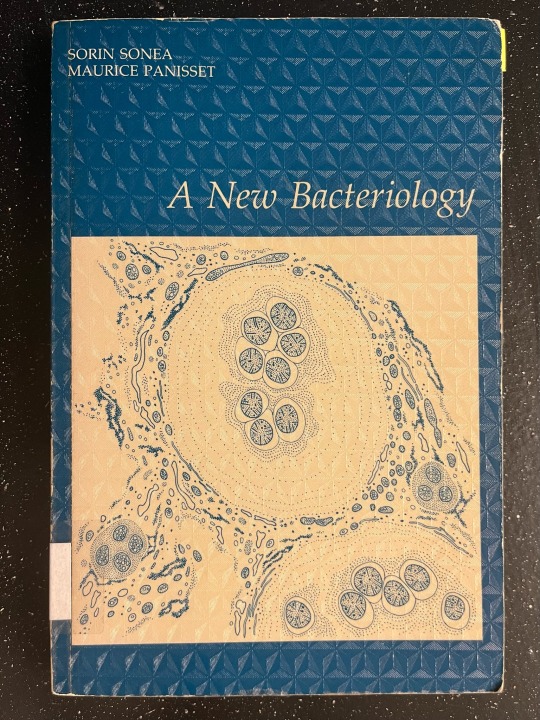
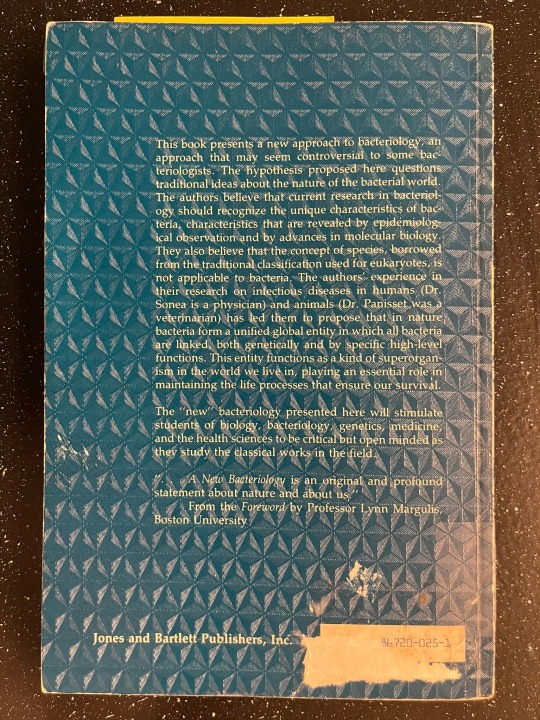


Evidently there exists an ISBN for a clothbound edition, but I’ve only ever seen the paperbacks.
The How
I probably first encountered the title in a David Quammen book or something, but I didn't hunt down a copy until I made friends with a former professor in the philosophy of biology. He didn't/doesn't work on systematics, but somehow or another this got mentioned and I found a used copy on eBay. This has never been reprinted and scans are scarce; these days the online secondhand market seems spooky. As always, let me know if you want a look inside and I'll hook you up.
The Text
I can't say much about either author — Panisset died in '81 and I frankly haven't bothered to track down any of Sonea's other stuff. Microbiologists both, of course, working while the field was in profound flux. Endosymbiotic theory had only been substantiated by Lynn Margulis in '67, and Archaea weren't defined until a decade later, in the early stages of this book's composition. Both of those are important here.


This is not a gentle book. It's a manifesto with several interests, most salient of which is the argument that various modes of horizontal gene transfer, limited local genetic information, and co-evolution of bacterial 'teams' makes all 'bacteria' (these days we'd say prokaryotes; the usually mean to include what we'd now call Archaea) parts of a global superorganism. Under this view, species are bunk; bacteriophages are less virus and more a tool of bacterial evolution; most microbiologists are basically close-minded. Oh, and because of all of that, the Gaia hypothesis is correct. There's a lot going on here. Lynn Margulis wrote the intro to this version and is mentioned several times throughout, if you can imagine that. I do not have enough space here to say all I want to about that and her, so let it suffice that it makes complete sense she went to bat for this.
If the book is interesting for anything, it's the way it goes about structuring its arguments. It is basically a philosophical artifact; there's no new wet work going on at all, and appeals to, say, numbers and novel observations and discrete mechanisms are sparse. That it works like a philosophy of biology book but is aimed at biologists as such is probably its greatest rhetorical weakness (if you’re not counting the usually Gaia stuff). There are some fascinating rhetorical slants going on around gene transfer mechanisms that I'll mention exist; say so if you want to hear more.
If their gripes about their field hold any water, there are some deep and complicated implications for the rest of biology in light of work done since the 80s. The conclusions drawn here are often silly, mostly toothless, and politically a bit dicey, but some of their insights have (through other channels, usually with different flavors) come to widespread, if tacit, acceptance anyway. I think I'm comfortable calling this recommended, but certainly not endorsed, reading.
The Object
Eh. Small publishing house doing what it could with a rather complicated job. The typesetting and printing is completely adequate but a little frustrating in the way that basically all biology writing is. The early 80s were especially bland in scientific publishing; absolutely no frills or risky moves. A bit of a shame, but I'm used to the disappointment.
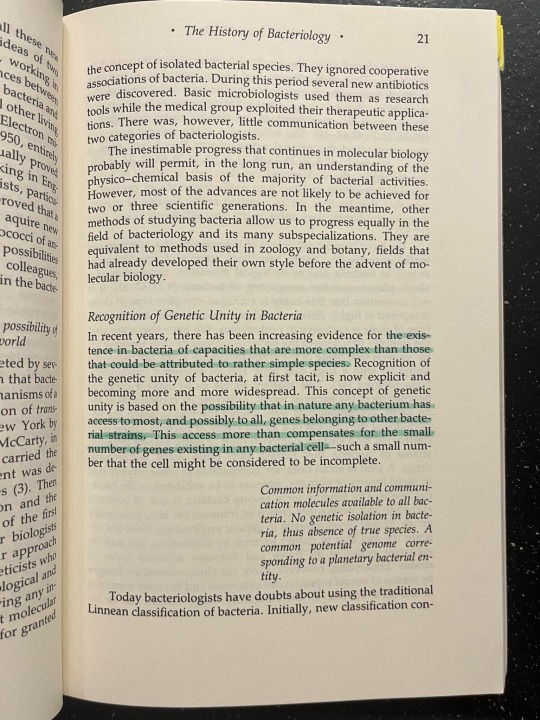
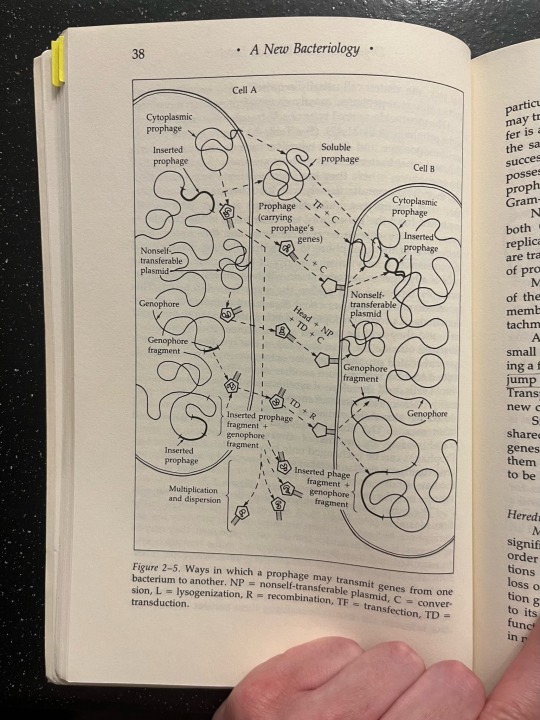
This copy needs repairs, but not so urgently I'll likely have them made any time soon. It's stable, at least for another decade or so. Interestingly a previous owner made notes in French.
The Why, Though?
Because I expected it to give me complicated feelings and also because it did. As a bonus, if I ever need to launder my sympathies for systematic radicalism as a passing academic interest, having a slightly ratty copy of this on my shelf will probably do the trick.
27 notes
·
View notes
Text
🌍 Gaia, ¿es la TIERRA un Ser VIVO? | 🎬 DOCUMENTAL
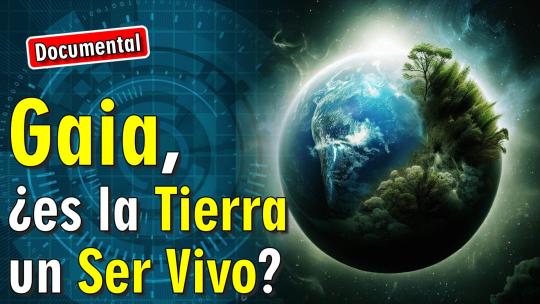
La hipótesis Gaia: ¿Es realmente la Tierra un ente vivo?
La llamada Hipótesis Gaia es tan famosa como controvertida: propone que todo el planeta es una especie de organismo gigante compuesto por elementos (humanos, otros animales, plantas, bacterias, rocas, algas, metales) que interactúan entre sí de maneras en su mayoría invisibles para mantener condiciones estables.
Fue propuesta por James Lovelock en la década de 1970 y rápidamente ganó notoriedad, tanto en el ámbito científico como en otros. Pero, ¿en qué consiste exactamente? ¿Puede haber algo de verdad en lo que podría parecer una de las muchas leyendas de la nueva era de nuestra época? Además, nos hacemos esta pregunta apenas unos meses después del fallecimiento de su creador el pasado julio, a la increíble edad de 103 años.
El documental:
https://youtu.be/uy-G2l1mcPI
Gaia, ¿es la TIERRA un Ser VIVO?:
Uno de los muchos obstáculos para la aceptación completa de la amenaza del calentamiento global es la terca noción de que los humanos no tienen suficiente poder para influir en el clima de todo el planeta. En realidad, no somos las únicas criaturas con tal poder, ni somos la primera especie en devastar el ecosistema global. De hecho, la historia de la vida en la Tierra es la historia de la vida reconstruyendo continuamente la Tierra.
Intentemos pensar en ello... Los árboles, las algas y otros organismos fotosintéticos producen la mayor parte del oxígeno respirable del mundo, ayudando a mantenerlo a un nivel lo suficientemente alto como para mantener la vida compleja, pero no tan alto como para que la Tierra estalle en llamas al menor chisporroteo.
El fitoplancton oceánico impulsa los ciclos químicos de los que depende toda la vida y emite gases que aumentan la cobertura de nubes, alterando el clima global. Las algas, los arrecifes de coral y los moluscos almacenan enormes cantidades de carbono, equilibran la química de los océanos y defienden las costas de los elementos. Y una amplia variedad de animales, como elefantes, lombrices de tierra y termitas, escarban continuamente en la corteza del planeta, alterando el flujo de agua, aire y nutrientes, y mejorando las perspectivas de millones de otras especies.
Bueno... es precisamente en estas sugerencias en las que se basa la llamada Hipótesis Gaia. Concebida por el químico británico James Lovelock a principios de la década de 1970 y posteriormente desarrollada con la bióloga estadounidense Lynn Margulis, la Hipótesis Gaia (llamada así en honor a los antiguos griegos y la diosa que representaba la Tierra) propone que todos los elementos vivos y no vivos de la Tierra son "partes y socios de un gran ser vivo que en su totalidad tiene el poder de mantener nuestro planeta como un hábitat adecuado y cómodo para la vida".
Aunque esta audaz idea ha encontrado una recepción entusiasta entre el público en general desde el principio, muchos científicos la han criticado y ridiculizado en su lugar.
"Preferiría que la hipótesis de Gaia se mantuviera en su hábitat natural de las estanterías de libros de divulgación científica en lugar de ensuciar trabajos de estudio serio", escribió el biólogo evolutivo Graham Bell en 1987.
El microbiólogo John Postgate fue particularmente vehemente: "¡Gaia, la Gran Madre Tierra! ¡El organismo planetario! ¿Soy el único biólogo que sufre una sensación de irrealidad cuando los medios una vez más me invitan a tomar en serio estas conjeturas absurdas?"
Sin embargo, con el tiempo, la oposición de la comunidad científica a Gaia ha disminuido. En sus escritos iniciales, Lovelock quizás había ido un poco demasiado lejos, alentando así la percepción errónea de que la Tierra viva expresaba su propia voluntad, lo cual obviamente no es fácil de aceptar.
Pero dejando de lado estas exageraciones, la esencia de su hipótesis, la idea de que la vida transforma y en muchos casos regula las transformaciones del planeta, ha demostrado ser profética y profundamente verdadera desde el punto de vista filosófico.
Nosotros y todas las criaturas vivientes no somos solo habitantes de la Tierra... ¡SOMOS la Tierra! Somos una consecuencia de su estructura física y un motor de sus ciclos globales. Y aunque algunos científicos siguen manteniéndose alejados de Gaia, estas verdades de alguna manera se han convertido en parte de la ciencia oficial también.
Aquellos que se oponen a la idea de un planeta vivo argumentan que la Tierra no puede estar viva porque no come, se reproduce ni evoluciona. Sin embargo, la ciencia nunca ha establecido una definición precisa y universalmente aceptada de la vida, solo una larga lista de sus cualidades.
Al igual que muchas criaturas vivas, la Tierra tiene una estructura altamente organizada, una membrana y ritmos diarios; consume, almacena y transforma energía; y si microbios que atacan asteroides o seres humanos viajeros por el espacio colonizan otros mundos, ¿quién dice que los planetas no pueden procrear? Si la Tierra respira, suda y tiembla, si da a luz a miles de millones de organismos que devoran, transforman y llenan incesantemente su aire, agua y rocas, y si esas criaturas y sus entornos físicos evolucionan en conjunto, ¿por qué no deberíamos considerar nuestro planeta como vivo?
Esta es en parte la posición de quienes apoyan la Hipótesis Gaia con sus corazones, pero ¿cuáles son los mecanismos biológicos detrás de tal conjetura? ¿Existen? Bueno... ¿Sabías, por ejemplo, que el científico británico James Lovelock, la persona más responsable de la hipótesis Gaia, estaba trabajando para la NASA cuando llegó por primera vez a su percepción de un sistema vivo al cuestionar "¿está viva la Tierra?"?
Sorprendentemente, en ese momento estaba creando pruebas para detectar vida en Marte. En ese momento, era 1965, la NASA estaba planeando enviar misiones automatizadas a la Luna, Marte y Venus, y uno de los objetivos era probar primero si esos entornos podían albergar organismos vivos de algún tipo. Por lo tanto, era necesario contar con un método para averiguarlo, comenzando con el examen de algunos elementos, en la pequeña parte que podía explorarse desde la Tierra.
Lovelock había adoptado la idea de que, en lugar de que las sondas realizaran minúsculas pruebas de suelo en el planeta rojo (utilizando lo que describió como "detectores de pulgas glorificados"), los científicos deberían examinar la atmósfera de Marte para ver si tenía concentraciones de gases que solo podrían existir si fueran mantenidos por organismos vivos.
Para probar esa idea, Lovelock observó la atmósfera de nuestro propio planeta. Y, efectivamente, el aire de la Tierra contiene grandes cantidades de gases altamente reactivos, como oxígeno y metano, que naturalmente se descomponen en otros compuestos. "Si solo importara la termodinámica química", escribió, "casi todo el oxígeno y la mayor parte del nitrógeno en la atmósfera deberían haber terminado en el mar combinados como ion nitrato".
Este sencillo descubrimiento más tarde se convirtió en uno de los argumentos originales de Lovelock a favor de Gaia: Algo mantiene numerosos gases reactivos en nuestra atmósfera en un estado de equilibrio constante. (Marte, por cierto, suspendió el "test de atmósfera activa"). El segundo argumento, aún más convincente, fue que a lo largo de los milenios, la Tierra de alguna manera ha regulado su propia temperatura. Cuando la vida comenzó en nuestro planeta hace cuatro mil millones de años, el sol estaba un 30% más frío de lo que está hoy.
Sin embargo, desde entonces hasta ahora, la temperatura de la superficie de la Tierra ha permanecido dentro del rango crítico de soporte de la vida, que va de 15 a 30 grados Celsius.
El nivel de CO2 se ha reducido cien veces en esos cuatro mil millones de años, disminuyendo el efecto de retención de calor del "efecto invernadero" de la atmósfera incluso mientras el sol irradiaba más calor. ¿El resultado? La Tierra se ha mantenido a una temperatura constante... ¡igual que nuestros propios cuerpos! La temperatura y una atmósfera reactiva son solo dos de los factores mantenidos en equilibrio por la Tierra.
También debemos notar que si, como Lovelock afirma, "la humedad, la salinidad, la acidez o cualquiera de una serie de otras variables hubiera salido de un rango estrecho de valores durante algún tiempo, la vida habría sido aniquilada".
Los mecanismos interactivos que logran esta autorregulación son demasiado complejos para que la ciencia actual los pueda cuantificar, por lo que Lovelock a menudo utiliza un modelo simplificado de un "Mundo de las Margaritas" imaginario para sugerir cómo podría funcionar el sistema.
Supongamos que hubiera un planeta que solo admitiera dos especies de plantas, margaritas blancas y margaritas negras. Dado que las blancas reflejan más calor que las negras, les iría mejor cuando el planeta estuviera inusualmente caliente. Lo contrario también sería cierto: las margaritas negras, al ser mejores absorbentes de calor, podrían sobrevivir mejor durante los períodos fríos.
Pero, ¿qué sucedería si el Mundo de las Margaritas estuviera frío durante un período prolongado? Las margaritas negras tomarían cada vez más la superficie terrestre, aumentando la capacidad de absorción del planeta y, por lo tanto, calentándolo. Con el tiempo, la temperatura subiría al rango ideal para las margaritas blancas. Estas se propagarían y las negras retrocederían en gran medida. Pero ese evento aumentaría la reflectividad del calor del planeta, enfriando eventualmente su superficie.
De esta manera, las margaritas negras y blancas se equilibrarían mutuamente y mantendrían la temperatura del planeta sin llegar nunca a ser demasiado caliente o demasiado fría para mantener la vida vegetal. En un nivel mucho más complejo, los organismos en nuestro propio planeta deben trabajar juntos para estabilizar la Tierra.
En resumen, la hipótesis de Gaia ve la Tierra como un sistema de autorregulación capaz de mantener el clima, la atmósfera, el suelo y la composición del océano en un estado fijo favorable para la vida.
A menudo se considera que la capacidad de autorregulación frente a perturbaciones, cambios, desastres, etc., es una característica muy fuerte de los seres vivos y, en ese sentido, la Tierra es un ser vivo. Pero en realidad, ¿está viva la Tierra? Lovelock está diciendo que la evolución de la vida y la evolución del planeta no han sido fenómenos separados, sino un proceso único y estrechamente acoplado.
La vida no se adapta simplemente a su entorno, sino que, a través de varios bucles de retroalimentación, coevoluciona con él. Esta visión unificadora de sistemas completos está comenzando a ganar terreno entre los científicos. Y la fascinante búsqueda de los mecanismos de Gaia ya está llevando a nuevas áreas de exploración.
La bióloga Lynn Margulis, que trabajó estrechamente con Lovelock en la hipótesis original, ahora estudia los roles que pueden desempeñar los resistentes microorganismos en la regulación de la atmósfera. Ha encontrado alrededor de 200 microorganismos en su mayoría inactivos en muestras de cultivos diminutos, cada uno listo bajo las condiciones adecuadas para realizar su función y emitir su emisión gaseosa particular, según las condiciones circundantes.
El científico atmosférico Pat Zimmerman examinó las bacterias intestinales de las termitas como fuente de metano atmosférico y descubrió que, dado que hay aproximadamente 700 kilogramos de termitas por cada ser humano en la Tierra, y dado que estos devoradores de madera consumen el equivalente a un tercio del carbono vegetal nuevo creado cada año, ¡pueden producir la mitad del metano en la atmósfera!
Sin embargo, las palabras de Lovelock a veces han sugerido que la totalidad de la vida en el planeta está trabajando deliberadamente para mejorar su condición y aumentarse a sí misma. Agregar tal aspecto de intencionalidad (incluso conciencia) a Gaia choca con la mayoría de los científicos, por lo demás, simpatizantes.
Cualquier indicio de que todo el sistema pueda estar realmente vivo es tabú para ellos; eso es hablar de religión. Y nunca debemos olvidar que la ciencia y el espíritu son diferentes ámbitos. No están en conflicto, pero no hay una interfaz entre los dos. No hay previsión ni planificación involucrados por parte de la vida en la regulación del planeta. Es solo un tipo de proceso automático.
La vida regula la estabilidad de la atmósfera para que pueda sobrevivir. Esto no es una directriz intencional, sino el resultado de millones de años de interacciones entre la vida y la atmósfera de la Tierra; uno no puede ser visto sin el otro. La vida y la Tierra, según Lovelock, son uno. Eso no ha impedido que muchos no científicos saquen sus propias conclusiones sobre las implicaciones de la hipótesis de Gaia.
Si bien la comunidad científica acredita a Gaia por proporcionar a los ecologistas y climatólogos una nueva clave para el estudio del planeta (vinculando cosas que antes se consideraban distantes, como las actividades humanas y los ecosistemas), esta teoría siempre ha sido problemática tanto como teoría como hipótesis.
Es imposible ponerla a prueba, y para los críticos, Gaia siempre ha sido una idea en conflicto con teorías y paradigmas probados, como la evolución darwiniana, que no encaja bien con la idea de que todo un planeta de alguna manera coopera para el bien de todos. Los ciclos biogeoquímicos existen, al igual que la capacidad de los ecosistemas para resistir el cambio, pero eso no significa que debamos inferir que el planeta tiene un propósito.
A lo largo de los años, Stephen Jay Gould y otros pesos pesados de la evolución han desafiado a Gaia en este mismo sentido. Fuera del mundo académico, Gaia es ahora en cambio una entidad muy fuerte y popular. Su mensaje es tan penetrante y ecuménico que, diluido y a menudo distorsionado, ha llegado a influir en novelas de ciencia ficción de culto y superproducciones cinematográficas como Avatar, reflexiones zen y ensayos populares, planes de estudio escolares y documentales.
Es una gran visión que, una vez más, desplaza a los seres humanos del centro del universo; vivimos en un sistema complejo sinérgico y autorregulador, perfecto para transmitir un cierto tipo de ambientalismo. Entonces, ¿qué podemos decir? Es muy probable que también necesitemos un componente emocional para desencadenar nuestras especulaciones científicas, una motivación que pueda abrir una puerta en nuestras mentes, incluso si es con la llave equivocada.
Te puede interesar:
- 🤩 Quedarás Impresionado con estos 14 Inventos del Futuro
- 😀 Disfrutarás viendo estos 15 DISPOSITIVOS con la mejor Tecnología
Read the full article
3 notes
·
View notes